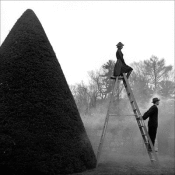 Towards the end of last year I wrote a series of pieces on the practical steps companies can take to unlock the economic value of their creativity. A process I called the Art of Change.
Towards the end of last year I wrote a series of pieces on the practical steps companies can take to unlock the economic value of their creativity. A process I called the Art of Change.
The Art of Change, I believe, is the series of steps by which a company transforms itself from what made it successful into what will.
Today, I want to place those steps into broader context and see what you think about a piece of thinking I’m developing.
The greatest challenge we face when building a business is to create an organizational model that possesses a limitless ability to re-imagine the future, and a tireless capacity to make that future come true. This ability separates the fashionable from the formidable. The temporary from the timeless.
It is a challenge that most creative companies fail.
Which has created an industry largely divided between a small set of very large, old businesses, struggling to re-define and restructure themselves - at enormous cost to employees, clients, suppliers and shareholders alike.
And a large set of small, fragile ones. Those who are essentially doing what they have always done. And for whom the world has not yet made that irrelevant.
This is not an industry model designed to create long term value. The choice being to invest in the big and slow. Or the small and frail.
Better by far, would be an industry in which the ability to see a different future and then to turn that into the practical was not just what it sold its clients but how it ran its businesses.
Which would produce fluid companies of all sizes and shapes. The long term value of which would depend on their owners’ appetites for growth. Not their reactive willingness to sell the same services for less, or accept lousy business terms as a fundamental business strategy.
There are many reasons for the inability of creative companies to unlock the power of their own talents when it comes to building more agile, fluid businesses. But most significant among them is that they set the bar too high when it comes to turning theory into reality.
This, I have come to realize, is because they ignore a foundational discipline on which, as humans, we base our personal evolution.
Practice.
As children, we fill pages of exercise books with practice signatures long before we unveil our personal mark on the world.
When we take up a musical instrument, try out for a new sport, get a part in the school play, prepare for exams or learn to drive, we practice. In some cases we practice how our breathing affects our performance. Which means that essentially we're practicing living.
We practice because we understand that there is risk in new things and we want to limit the damage - to our ego or to our safety - until we are confident we can produce a minimum standard. Or decide that this is an endeavor worth pursuing.
This openness to trial and refinement is embedded into the public presentation of most forms of creative expression. We expect the orchestra to rehearse. The writer to edit. The painter and sculptor and photographer to curate. The director to try it multiple ways but show us the best one.
This is true of software development and product development, which design practice into the cycles by which new offerings are brought to market. For what is prototyping but trial, error, refinement and retrial? Practice by another name.
And this is true in professional sports. The pitcher who throws a new pitch for the first time on a full count with the bases loaded in the bottom of the ninth, is not likely to be making his living in baseball for long. And in American Football, the Hail Mary is in fact practiced desperation.
But when it comes to building a creative business, we seem to be guided by a rule that says there can be no preparation. There can be no trial. We do what we've always done. Or we do something different. Tomorrow.
An all or nothing strategy that creates a threshold for change which is too high for all but the most desperate, or the most risk taking, or the most wealthy. And a start date that it always too soon.
And so faced by a choice between the status quo and the unknown, most creative companies choose neither. Until the status quo looks like Lakeshore Drive last Wednesday morning, and the unknown is no longer a careful journey along side streets, but a white-out blizzard in 60 mph winds.
For creative businesses, the Art of Change is unlocked when you build an organizational model that perfectly delivers what your clients expect today, while you practice tomorrow.
A model that allows you to explore new possibilities and practice new skills off to the side, out of sight of the public eye, until you're confident they should be brought into the open. Or discarded without regret.
A model that reduces risk and increases confidence, and allows change to be fluid and evolutionary. One that shows progress only through time-lapse photography because the degree of difference between what you did yesterday and what you did today is almost imperceptible to the naked eye. But over time turns a seed into a flower, and dirt into a garden.
I’m curious whether this idea of embedding practice into your business resonates with you? And how you think it can be best applied? Feel free to post as comments here. Or via email if you’d rather practice your public discourse privately first.
Over the next couple of weeks I’ll share some of your observations and add my own insights about where I’ve seen practice work, and where it does not.



















